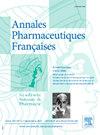Cranio-facial trauma diagnosis using paleo-proteotyping of a blood sample from Robespierre (1794)
IF 1.1
Q4 PHARMACOLOGY & PHARMACY
引用次数: 0
Abstract
Tradition has it that the politician Robespierre, a famous tribune of the French Revolution, was lying, wounded in the face by a bullet from a firearm, on an 18th century desk, and left a trace of blood there, before being guillotined the next day (1794). This piece of furniture is now kept in the National Archives (Paris, France). A paleo-proteomic study was carried out on several brown stains on the leather of the desk, which confirmed the human blood nature of the sample, but also identified the protein signature of different cranio-facial organs. This confirms not only the historical anecdote surrounding this desk, but also the importance of contemporary ballistic lesions on the eve of Robespierre's death. This demonstrates the importance and precision of paleo-proteomics in paleopathology and for the examination and identification of the precise nature of stains and micro-traces on old samples.
La tradition rapporte que le politicien Robespierre, célèbre tribun de la Révolution française, aurait été allongé, blessé au visage par un projectile à balle d’arme à feu, sur un bureau du 18e siècle, et y aurait laissé une trace de sang, avant d’être guillotiné le lendemain (1794). Ce meuble est désormais conservé aux Archives nationales (Paris, France). Une étude en paléo-protéomique a été réalisée sur plusieurs taches brunes sur le cuir du bureau, qui a permis de confirmer la nature sanguine humaine de l’échantillon, mais aussi d’identifier la signature protéique de différents organes crânio-faciaux. Ainsi est confirmée non seulement l’anecdote historique autour de ce bureau, mais aussi l’importance des lésions balistiques contemporaines de la veille de la mort de Robespierre. Ainsi sont démontrés l’importance et la précision de la paléo-protéomique en paléo-pathologie et pour l’examen et l’identification de la nature précise de taches et micro-traces sur échantillons anciens.
利用罗伯斯庇尔(1794)血液样本的古蛋白质分型进行颅面创伤诊断。
传统的说法是,政治家罗伯斯庇尔,一位著名的法国大革命论坛官,躺在一张18世纪的桌子上,脸上被一颗枪射出的子弹打伤,在那里留下了血迹,第二天(1794年)被送上了断头台。这件家具现在保存在法国巴黎的国家档案馆。对桌子皮革上的几处棕色污渍进行了古蛋白质组学研究,证实了样本的人类血液性质,同时也鉴定了不同颅面器官的蛋白质特征。这不仅证实了这张桌子周围的历史轶事,也证实了罗伯斯庇尔去世前夕当代弹道损伤的重要性。这证明了古蛋白质组学在古病理学中的重要性和准确性,以及对古老样本上的污渍和微痕迹的精确性质的检查和鉴定。
本文章由计算机程序翻译,如有差异,请以英文原文为准。
求助全文
约1分钟内获得全文
求助全文
来源期刊

Annales pharmaceutiques francaises
PHARMACOLOGY & PHARMACY-
CiteScore
1.70
自引率
7.70%
发文量
98
期刊介绍:
This journal proposes a scientific information validated and indexed to be informed about the last research works in all the domains interesting the pharmacy. The original works, general reviews, the focusing, the brief notes, subjected by the best academics and the professionals, propose a synthetic approach of the last progress accomplished in the concerned sectors. The thematic Sessions and the – life of the Academy – resume the communications which, presented in front of the national Academy of pharmacy, are in the heart of the current events.
 求助内容:
求助内容: 应助结果提醒方式:
应助结果提醒方式:


